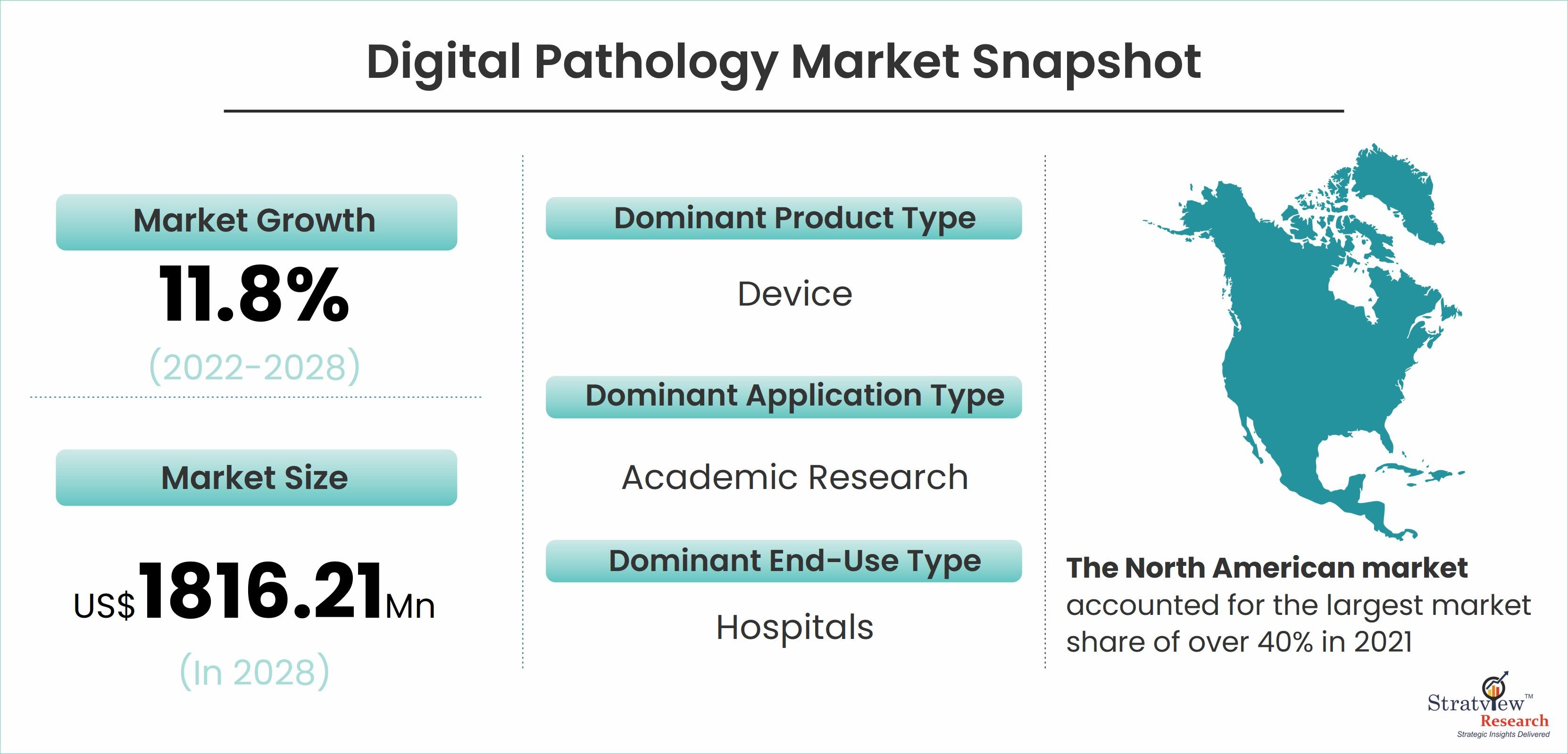Revolutionizing Diagnostics: The Rise of Digital Pathology

In the world of healthcare, precision and accuracy are paramount. The ability to diagnose diseases with utmost certainty can be the difference between life and death. Traditionally, this process has relied heavily on the expertise of pathologists who meticulously examine tissue samples under a microscope. However, a groundbreaking transformation is underway, poised to revolutionize diagnostics as we know it - the rise of Digital Pathology.
According to Stratview Research, the Global Digital Pathology Market is expected to grow from USD 831.45 million in 2021 to USD 1816.21 million by 2028 at a CAGR of over 11.8% during the forecast period of 2022-2028.
Digital pathology is referred to as an image-based information setting that is enabled by computer technology which allows the management of information generated via a digital slide. Digitalization of pathology has further led to the automation of tests during disease diagnosis among other applications.
A single digital device can perform tests that were previously carried out using five instruments by pathologists. These solutions offer analysis & scrutiny of images on a computer, online storage of digital slides, and high-resolution sample scanning, which helps pathologists to cross-examine slides without physical evidence.
To learn more about the report, click here:
https://www.stratviewresearch.com/1566/digital-pathology-market.html
The Convergence of Technology and Medicine
Digital Pathology represents a seamless integration of cutting-edge technology with the field of medicine. At its core, it involves the conversion of glass slides containing tissue samples into high-resolution digital images. These images are then analyzed, stored, and shared using sophisticated computer systems, rather than traditional microscopes.
This convergence brings forth a multitude of advantages that have the potential to reshape the landscape of diagnostic medicine.
Unprecedented Precision through Image Analysis
One of the most significant advantages of Digital Pathology is the power of image analysis. Advanced algorithms and artificial intelligence are capable of detecting minute details and patterns that may escape even the most astute human eye. This leads to enhanced accuracy in diagnosis and allows for early detection of diseases, significantly improving patient outcomes.
For instance, in the realm of cancer diagnostics, Digital Pathology enables the identification of subtle cellular changes that might indicate the presence of malignancy at an earlier, more treatable stage.
Overcoming Geographic Barriers with Telepathology
Digital Pathology also transcends geographical limitations through a practice known as Telepathology. This involves the remote transmission of pathology images for consultation, making expertise accessible in regions where it may be scarce. This democratization of diagnostic services has the potential to revolutionize healthcare in underserved areas and streamline second opinions in complex cases.
Streamlined Workflow and Enhanced Collaboration
The transition to digital platforms streamlines the workflow in pathology laboratories. Digital images can be archived, retrieved, and shared with ease, eliminating the logistical challenges associated with physical slide transport. This not only saves time but also reduces the risk of sample degradation or loss.
Moreover, Digital Pathology facilitates collaborative efforts among pathologists and multidisciplinary healthcare teams. Experts from different specialties can simultaneously review and discuss cases, leading to more comprehensive and integrated patient care.
Leveraging Big Data for Insights and Research
The accumulation of vast amounts of digital pathology data creates unprecedented opportunities for research and insights. By harnessing the power of Big Data analytics, patterns, trends, and correlations can be identified on a scale previously unimaginable. This not only fuels advancements in diagnostic accuracy but also paves the way for groundbreaking discoveries in the understanding and treatment of various diseases.
Navigating the Transition: Challenges and Solutions
While the benefits of Digital Pathology are clear, its widespread adoption is not without challenges. Integration with existing laboratory systems, ensuring data security and compliance with regulatory standards, and initial capital investment are some of the hurdles that institutions may face. However, with strategic planning, robust training programs, and a commitment to technological infrastructure, these challenges can be effectively addressed.
The Future is Now
As we stand on the cusp of a new era in diagnostics, Digital Pathology emerges as a transformative force in healthcare. Its potential to enhance precision, accessibility, and collaboration holds immense promise for patients and healthcare providers alike. With continued research, innovation, and a collective commitment to its advancement, Digital Pathology is poised to revolutionize diagnostics and, ultimately, elevate the standard of patient care worldwide.
About Us
Stratview Research is a global market research firm, offering syndicated and custom research reports along with growth consulting services. Our business intelligence and industry research reports offer clients insightful market data to aid strategic decision-making. These exclusive reports are the result of exclusive research methodology and are available for key industries such as chemicals, composites, advanced materials, technology, renewable energy, and more.
Stratview Research delivers custom research services across sectors. In case of any custom research requirements, please send your inquiry to sales@stratviewresearch.com or connect with our experts at +1-313-307-4176.
- Art
- Causes
- Crafts
- Dance
- Drinks
- Film
- Fitness
- Food
- Games
- Gardening
- Health
- Home
- Literature
- Music
- Networking
- Other
- Party
- Religion
- Shopping
- Sports
- Theater
- Wellness
- IT, Cloud, Software and Technology


